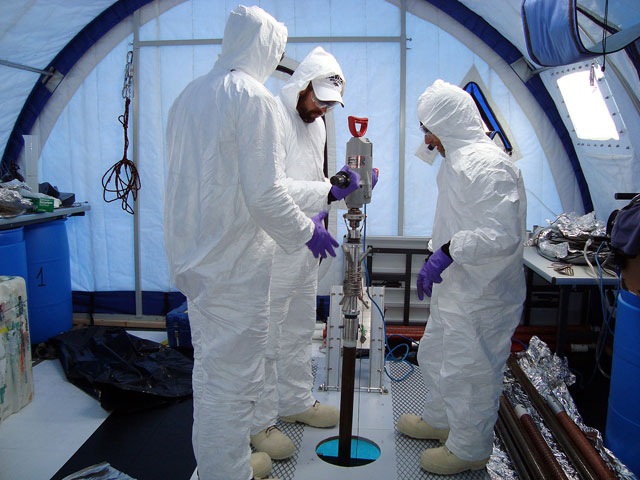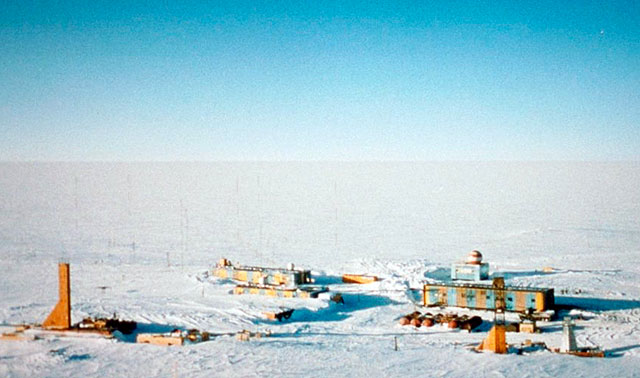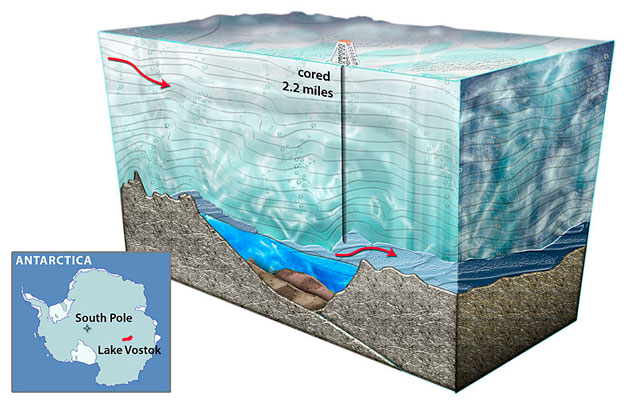BreakthroughRussian scientists penetrate subglacial lake for the first timePosted February 10, 2012
Reports this week confirm that Russian scientists have penetrated a lake buried deep under an ice sheet in remote East Antarctica after about two decades of drilling. This is the first time scientists have successfully accessed a subglacial lake. Lake Vostok is believed to be the largest of several hundred such under-ice lakes around Antarctica, about the size of Lake Ontario. Scientists are hopeful they may find life in the freshwater body that has been isolated from the environment for possibly millions of years. “Their efforts will transform the way we do science in Antarctica and provide us with an entirely new view of what exists under the vast Antarctic ice sheet,” said John Priscu Priscu was the lead author on the first paper published about life in Lake Vostok in the journal Science in 1999, using ice cores drilled from above the lake. He is currently the chief scientist on a U.S. Antarctic Program The British Antarctic Survey Some researchers have expressed concern over possible contamination of Lake Vostok by the drilling fluid used by the Russian team. In the end, the Russians flooded the bottom of the hole with Freon and used a heated drill tip for the final boring effort. In theory, the water pressure from the lake would flood the bottom of the hole without allowing any drill fluid to enter the lake, quickly freezing into a plug that scientists can later carefully drill through next year. Alison Murray 
Photo Credit: Ema Kuhn
Members of the Lake Vida expedition team use stringent procedures to ensure drilling does not contaminate the frozen body of water.
To avoid contamination of Lake Vida, Murray’s team set up stringent protocols to keep the drill site and equipment clean, including sterilizing equipment as if they were surgical tools and dosing instruments with ultraviolet radiation for good measure. “Though the scale of our study system is shallow, small and young in geological time in comparison to most subglacial lakes, and Vostok in particular, the awareness of environmental stewardship has been held high, and we have been fortunate to test new approaches in this much more accessible system,” she said via email. “Drilling into Lake Vostok presents probably the most complicated of subglacial lakes to access due to the long duration of the drilling project, depth of ice and movement of the ice sheets overlying the lake,” she added. “Even though the real advances in science following penetration of Lake Vostok and accessing water samples remain to be seen, this is a significant mark in history, and will open doors to understanding past climate, life and adaptations required for survival in this massive isolated body of water.” In a BBC report on Feb. 8, Valery Lukin, director of Russia’s Arctic and Antarctic Research Institute The scientists penetrated the lake just before the end of the Antarctic summer field season. Researchers are expected to return to the research base at Vostok Station in late 2012 when summer returns for further work on the subglacial lake.
|



For USAP Participants |
For The Public |
For Researchers and EducatorsContact UsNational Science FoundationOffice of Polar Programs Geosciences Directorate 2415 Eisenhower Avenue, Suite W7100 Alexandria, VA 22314 Sign up for the NSF Office of Polar Programs newsletter and events. Feedback Form |




